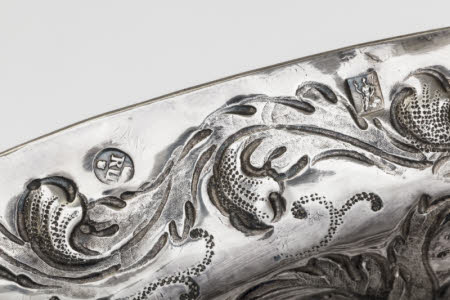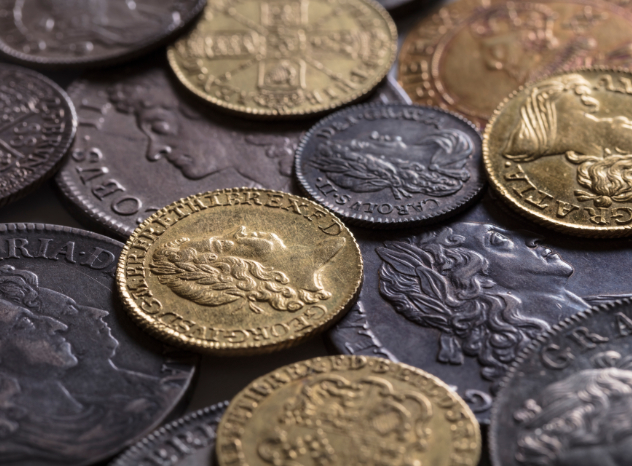Dish
John Ruslen (fl. 1664-1716)
Category
Silver
Date
1698 - 1699
Materials
Silver
Measurements
465 mm (Width) x 90 mm (Depth); 670 mm (Length)79 oz t (Wt)
Place of origin
London
Order this imageCollection
Osterley Park and House, London
NT 772350
Summary
A raised oval dish on four ball feet and with two handles (originally four) in Britannia silver made by John Ruslen (fl. 1664-1716) and presented to Sir Francis Child the Elder (1642-1713) during his term as Lord Mayor of London in 1698-9 by the Sephardi community of Spanish and Portuguese Jews. The sides and rim of the dish are chased in high relief with Dutch-style foliate and floral decoration and the base is in the form of an oval medallion containing a chased scene of a soldier holding a spear and standing by a tent with clouds above and a tree and a hill to either side. Above the tent, and protruding from it, is a pennant on which is a lion rampant, whilst below, in a foliate cartouche, is an engraved motto, ‘The arms of the Tribe of Judah given them by the Lord’. This scene is derived from the badge of the Spanish and Portuguese Jews in London who gave silver dishes, and later salvers and covered cups, to successive lord mayors from 1678 until 1780.
Full description
After an absence of nearly four centuries Jews were readmitted to England by Oliver Cromwell in 1656 and the policy of toleration was continued under Charles II. The Sephardi congregation of Spanish and Portuguese origin from Amsterdam was the first to establish itself, worshipping initially in a small building in Creechurch Lane in the City of London but in 1701 moving to a newly constructed synagogue off Bevis Marks which survives and ranks as the oldest in the country. Under constant threat of renewed persecution their leaders were careful to cultivate senior dignitaries and in particular the Lord Mayor. During the term of Sir Richard Ford, a moderate, in 1670-1, an inquiry into the conduct of the London Jews was proposed and this may well have prompted the gift to Ford of a pipe of wine valued at £48, plus 20 guineas to his son. Presents valued at £55 combined followed to two other Lord Mayors in the succeeding years and in 1678 a gift was made in the form of a ‘silver dish of 85¾ ounces at 5s. 10d. [per ounce]’ piled up with sweatmeats, the total cost being £27 11s. This set the pattern for the next century, albeit that chocolate succeeded sweetmeats in 1716, dishes were replaced by rectangular salvers (see NT 772343) from around 1730, and salvers had given way to two-handled cups and covers by 1745. From 1731, in addition, the gift was either in the form of wrought silver and chocolate or was made in cash. In 1780 depleted funds led to the Elders ending the practice. Of these gifts in silver to Lord Mayors, a total of twelve are known to survive comprising seven dishes of the original form, two salvers and three cups and covers. The earliest is a dish of 1697/8 which is now part of the church plate of St Michael’s, Bristol and it, like the Osterley dish, bears the mark of the goldsmith, John Ruslen. He was the favoured supplier of the Portuguese and Spanish Jews for nearly thirty years, first being recorded in their accounts in 1682 when he provided a sanctuary lamp weighing 124oz 13dwt. Sadly this does not survive but a set of silver handles and mounts for the scrolls of 1700 by him, which are the earliest surviving English-made examples, are still at Bevis Marks. The first five of the surviving silver dishes, dated from 1697/8 to 1710/11 are all by Ruslen who may, at least in part, have been chosen over a Huguenot so as not to antagonise the native born goldsmiths. He was recorded at the Golden Cup, St Swithin’s Lane, from 1690 to 1715 and he was still an active goldsmith when he wrote his Will in August, 1716, his success apparent from the significant sums he bequeathed. Ruslen’s dish of 1702/3 is now in the Jewish Museum of London whilst that of 1708/9 is in the Jewish Museum of New York and the fifth, of 1710/11, is at Grimsthorpe Castle. The costs associated with the Osterley dish are recorded in the Spanish and Portuguese Synagogue’s accounts as follows (translated from Portuguese): 6 January 1698 Account of the cost of the silver dish and sweets for the Lord Mayor is: For paid to the silversmith [Ruslen] of 85 oz ¼ @ 6s 5d [per ounce] £27-7-0 For sweets to Morais according to her memory £5-0-6 Given to the officials of the Lord Mayor £0-15-0 £33-2-6 Exactly when the presentation was made is not recorded but presumably there would have been a specific deputation of the Elders in the early part of the Lord Mayor’s term which commenced in November of each year. As it was during Sir Francis’s mayoralty that the site of the new, larger synagogue on Bevis Marks was acquired there would have been particular potency to the presentation in his case. Sir Francis was himself of a tolerant disposition, reputedly making a personal contribution of £500 for the relief of Huguenots whilst Lord Mayor. The form of the dish and its decoration is decidedly retardataire, following a fashion that was imported from the northern Netherlands at the Restoration and was at its peak in England in the 1660s. Examples include the London-made dish of 1662 surviving at Knole in Kent (130021, on loan from the Sackville Trustees), which is closely comparable to the Osterley dish, and Dean Fell’s altar service of 1661 at Christ Church Cathedral, Oxford. Dutch prowess at producing high relief chasing had been in evidence since the late sixteenth century and two plaques of exceptional quality from dishes of around 1600 survive at Anglesey Abbey (516393-4). Dutch silversmiths continued to produce chased scenes and floral decoration into the eighteenth century and the choice of style for the presentational pieces by the Portuguese and Spanish Jews of London could well have been the result of their close connection with the northern Netherlands. Their constitution was modelled on that of the Congregation Talmud Torah of Amsterdam and many of the early Elders came from that city, probably bringing liturgical plate with them. Silver produced in Amsterdam incorporated high relief chasing even into the eighteenth century and elaborate floral decoration akin to the Osterley dish is found on a Hanukah lamp of 1696 attributed to Pieter van Hoven in the Rijksmuseum (BK-1970-116). Floral chasing also continued to be employed into the latter decades of the seventeenth century in England to a certain extent and particularly for some large pieces of display plate, as is evidenced by two bottle cisterns in National Trust collections, that of 1680/1 by Robert Cooper at Ickworth (852068) and, of especial pertinence, that of 1695/6 attributed to Benjamin Bathurst at Osterley (772361). As originally made, the Osterley dish had four handles of foliate form applied by riveting centrally on the short and long sides of the rim. This conforms with all but one of the other dishes presented to Lord Mayors up to 1728 (that of the latter year being without both handles and the engraved inscription) and with the dish of similar form at Knole (see above). At some point after presentation, however, the protruding parts of the handles on the long sides were cut off and this must have been done to allow the dish to be upended for display on the sideboard. Such an action and the preservation of the dish through a period when it was common practice to melt down plate that was no longer fashionable suggests that the Childs took great pride in the piece. It is possible that it would have been displayed in Robert Adam’s new Eating Room, completed for Sir Francis’s grandson, Robert Child (1739-82) in the late 1760s. Agneta Yorke visited in 1772 and described Adam’s sideboard there as being ‘Magnificently furnished with plate, and under the Table was a Massy & large silver Cistern’. That cistern, as mentioned above, also exhibits floral chasing of the Dutch school and the Ruslen dish could have been placed above, alongside Paul de Lamerie’s magnificent gilt basin of 1736/7 (772342) which is noted in the 1782 inventory of Osterley as being ‘for the sideboard’. The dish is not, however, itself identifiable in the inventory and it could instead have been kept in the London house for use on the sideboard there. James Rothwell, Decorative Arts Curator (with information from Stephanie Souroujon) October 2019
Provenance
Given to Sir Francis Child (1642-1713) by the Spanish and Portuguese Jews of London in 1698-9. By descent to George Francis Child-Villiers, 9th Earl of Jersey (1910-98) and given by him to the National Trust in 1993.
Credit line
Osterley Park, the Jersey Collection (National Trust)
Marks and inscriptions
Front, engraved legend: THE ARMS OF THE TRIBE OF JUDAH GIVEN THEM BY THE LORD Front, on upper part of rim, stamped marks: ‘RU’ with a crown above and a shield below in an oval punch for John Ruslen (fl. 1664-1716, d. 1717); Britannia [indicating Britannia standard silver]; lion’s head erased [indicating London assay office]; date letter ‘C’ [indicating 1698/9].
Makers and roles
John Ruslen (fl. 1664-1716), goldsmith
References
Barnett 1931: Lionel Barnett (ed.), El Libro de Los Acuerdos, being the records and accompts of the Spanish and Portuguese Synagogue of London from 1663 to 1681, Oxford, 1931. Burman, Marin and Steadman 2006: Rickie Burman, Jennifer Marin and Lily Steadman, Treasures of Jewish Heritage: The Jewish Museum, London, 2006., pp.88-9 Grimwade 1958: Arthur Grimwade, ‘Anglo-Jewish Silver’, Transactions of the Jewish Historical Society of England, vol. XVIII (sessions 1953-55), London, 1958. Kleeblatt and Mann 1986: Norman L. Kleeblatt and Vivian B. Mann, Treasures of the Jewish Museum, New York, 1986., p. 78 Roth 1935: Cecil Roth, ‘The Lord Mayor’s Salvers’, Connoisseur, 96 (May 1935), 296-9. Schroder, 1995: Timothy Schroder. 'The Silver at Osterley.' Apollo 141.398 (June 1995): pp.23-26., p. 23




